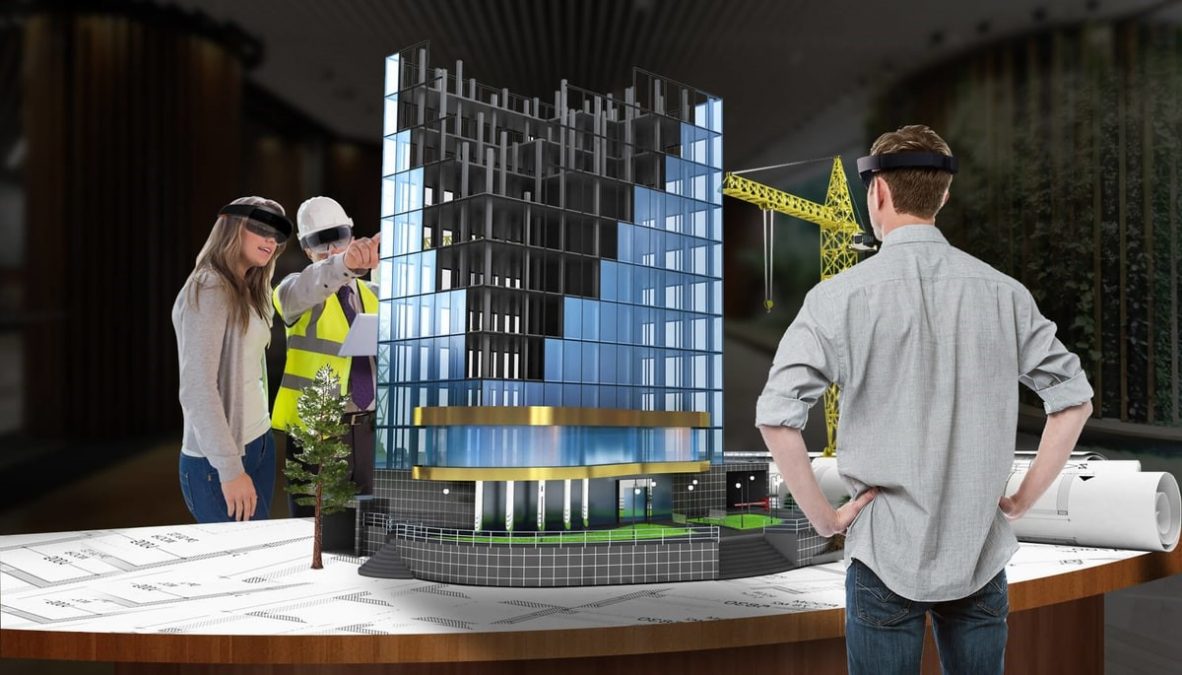TECHNOLOGY
How Virtual Reality Is Set To Change The Construction Industry

The use of virtual reality in construction can improve safety, precision and collaboration, saving contractors time and money.
Virtual reality (VR) is finally here and it is not just for gaming.
In fact, VR has begun to spread into almost every industry you can think of as more and more possible applications become known or invented, and the construction industry is certainly no exception. In the coming decades, the way that construction is done will change completely to make way for the time-saving and money-saving benefits offered by VR. Virtual reality is now capable of offering a really immersive experience that can be really helpful in industries like construction. In fact, construction may be the industry that is set to be changed the most by the usage of virtual and augmented reality.

Building Information Modelling (BIM) is one of the reasons why construction and virtual reality go so well together. BIM is being used more and more often for construction because of consumer demand. People want builders to provide them with a three-dimensional model of the project before the first nail is driven.
There are current methods of 3D modelling that are being used, but virtual reality has the potential to make these 3D models something that you could actually walk in and explore, giving developers the opportunity to interact with the design, see it up close and make changes that they can check in real-time. Being able to see a build in 3D through the lens of virtual reality means that builders can create better construction projects and spot problems before the building actually begins. This will save both time and money for builders and the potential customers asking for the build.

Obviously, there are some pretty big benefits to virtual reality as it stands now, but things are going to change in a huge way in the coming decades. What is possible now will seem like a drop in the bucket compared to what is coming with the pairing of virtual reality and the construction industry. This article will discuss this pairing now and in the future, and some of the exciting things that will be coming as a result of construction projects using virtual reality to model projects before the build begins.
3D Modelling and Virtual Reality

Architects and engineers use BIM to represent structures so that they will have a plan for construction that shows them where the flaws are in the architectural plan and any changes that need to be made. In the beginning stages of a project, 3D modelling is an important step because it saves the architect from having to go back and redesign something that didn’t work in the real world, and it saves the builder and person paying for the construction project money on wasted supplies and time that was used to build something that didn’t work.
But that is not the only way the current 3D modelling is used in construction. 3D modelling can demonstrate to the customer, the builder or anyone else who needs to know that the project has been built to specifications. It can be difficult to verify a building project from the architectural 2D plans, but a 3D model can demonstrate that the plans have been followed and that the design is accurate. But virtual reality can make this so much more accurate and easy to view.
Virtual reality gives builders and architects the opportunity to work with full-size structures in the VR environment instead of using the old method of scale models on computer screens or physical scale models.
Collaboration with Virtual Reality
One of the most exciting things in the construction field that can be done with virtual reality in a collaboration with other people. Collaboration is important because it is not just the architect or engineer that comes up with the initial design, it is also the client paying for the build. In addition, the builder should be able to check out what is being asked for as well to find out if it is possible, to give accurate quotes and to suggest improvements based on their own experience.
But it is not just the client, designer and builder that can add value to the construction project by being able to see it in virtual space. Today, hospitals are asking doctors and nurses to take a look at virtual reality constructs of new buildings to give valuable input as to how the room should be designed and what the layout should be. This is set to create transformative change for the healthcare industry and it starts at the ground floor with the construction of the project.

Virtual reality has so much potential when it comes to collaboration because as VR improves, people will be able to walk in and see exactly what their build is going to look like, and even do things like change paint colours, adjust options and basically have total freedom over what they want to be built using virtual reality.
Improving the Customer Experience with VR
Another thing the VR does is improve the customer experience. Developers that are selling houses off of plans are using virtual reality to show customers exactly what homes will be like once they are built and create a buying experience that they cannot get anywhere else. Customers are able to take a test drive of sorts in their home before they decide to build it. They may be able to look at dozens of different plans in order to figure out what they want, something that is relatively difficult to do when it comes to 3D modelling. Customers want this experience. They want to be able to see what they are getting before they buy.
In addition, as we previously discussed the customer is going to have an old great deal of freedom in the virtual reality space as well. With the standard 3D modelling mockup, it can be difficult to see yourself in that home. But when customers start adding things like coats of paint, curtains, furniture and all of the other things that go into a home, they are able to see themselves living there much more easily and end up getting the perfect home for themselves. The customer experience is one of the areas where VR is going to be the biggest enhancement. The finished product can be viewed long before it is completed and changed if necessary. Customization will definitely improve the customer experience.
Professional Training with Virtual Reality
Professional training in construction can also be done with virtual reality. There are lots of fields where professional training is going to be instrumental in training people to do the job, but construction is definitely one of them. It is a lot safer and less expensive to train someone on heavy equipment – and especially equipment like cranes – with modern virtual reality rather than in the real world. Right now, lots of people graduate school with degrees in engineering or architecture despite never having actually worked on a construction site. Many of them have never even seen one up close. But virtual reality is about to change all that.

Imagine how much more understanding and experience an engineer or architect will be able to bring to a job if they have actual experience working with their designs in the virtual world before they even graduate. In addition, people will learn to do dangerous jobs and operate extremely dangerous equipment in a safe environment where mistakes do not have the potential to cost a life. Virtual reality is almost vital when it comes to professional training in a variety of fields and that definitely includes construction. In a few decades, virtual reality will be almost indistinguishable from the real thing and that will mean some major advancements when it comes to the construction industry.
The Future of VR and Construction
The future of virtual reality is uncertain but only from the perspective that it is impossible to predict just how far virtual reality will bring the construction industry as well as all of the other industries that it can improve. There is no doubt that virtual reality is going to make a huge difference when it comes to construction; it is just that no one knows how far the technology will take us. It is very likely that in the near future, virtual reality will be the standard by which all construction projects are conceived and built. No construction project will be started or finalized until it has been built in virtual space first. But there is a lot more to it than that.
Right now, not that many companies are using virtual reality in order to improve their construction business, at least in meaningful ways. Not that many architects and engineers are using this technology yet either. But that is expected to change very soon. Firms are just barely starting to see the value of this technology, which is one of the reasons why the response has been slow. Another reason that companies have been slow to adopt virtual reality is that technology isn’t perfect yet. But that’s all going to change in the next 5 years as the technology fidelity catches up with mainstream renderings. In the future, it will be nearly perfect and everyone will be using it for an unforeseen number of applications.
Source link
TECHNOLOGY
Next-gen chips, Amazon Q, and speedy S3

AWS re:Invent, which has been taking place from November 27 and runs to December 1, has had its usual plethora of announcements: a total of 21 at time of print.
Perhaps not surprisingly, given the huge potential impact of generative AI – ChatGPT officially turns one year old today – a lot of focus has been on the AI side for AWS’ announcements, including a major partnership inked with NVIDIA across infrastructure, software, and services.
Yet there has been plenty more announced at the Las Vegas jamboree besides. Here, CloudTech rounds up the best of the rest:
Next-generation chips
This was the other major AI-focused announcement at re:Invent: the launch of two new chips, AWS Graviton4 and AWS Trainium2, for training and running AI and machine learning (ML) models, among other customer workloads. Graviton4 shapes up against its predecessor with 30% better compute performance, 50% more cores and 75% more memory bandwidth, while Trainium2 delivers up to four times faster training than before and will be able to be deployed in EC2 UltraClusters of up to 100,000 chips.
The EC2 UltraClusters are designed to ‘deliver the highest performance, most energy efficient AI model training infrastructure in the cloud’, as AWS puts it. With it, customers will be able to train large language models in ‘a fraction of the time’, as well as double energy efficiency.
As ever, AWS offers customers who are already utilising these tools. Databricks, Epic and SAP are among the companies cited as using the new AWS-designed chips.
Zero-ETL integrations
AWS announced new Amazon Aurora PostgreSQL, Amazon DynamoDB, and Amazon Relational Database Services (Amazon RDS) for MySQL integrations with Amazon Redshift, AWS’ cloud data warehouse. The zero-ETL integrations – eliminating the need to build ETL (extract, transform, load) data pipelines – make it easier to connect and analyse transactional data across various relational and non-relational databases in Amazon Redshift.
A simple example of how zero-ETL functions can be seen is in a hypothetical company which stores transactional data – time of transaction, items bought, where the transaction occurred – in a relational database, but use another analytics tool to analyse data in a non-relational database. To connect it all up, companies would previously have to construct ETL data pipelines which are a time and money sink.
The latest integrations “build on AWS’s zero-ETL foundation… so customers can quickly and easily connect all of their data, no matter where it lives,” the company said.
Amazon S3 Express One Zone
AWS announced the general availability of Amazon S3 Express One Zone, a new storage class purpose-built for customers’ most frequently-accessed data. Data access speed is up to 10 times faster and request costs up to 50% lower than standard S3. Companies can also opt to collocate their Amazon S3 Express One Zone data in the same availability zone as their compute resources.
Companies and partners who are using Amazon S3 Express One Zone include ChaosSearch, Cloudera, and Pinterest.
Amazon Q
A new product, and an interesting pivot, again with generative AI at its core. Amazon Q was announced as a ‘new type of generative AI-powered assistant’ which can be tailored to a customer’s business. “Customers can get fast, relevant answers to pressing questions, generate content, and take actions – all informed by a customer’s information repositories, code, and enterprise systems,” AWS added. The service also can assist companies building on AWS, as well as companies using AWS applications for business intelligence, contact centres, and supply chain management.
Customers cited as early adopters include Accenture, BMW and Wunderkind.
Want to learn more about cybersecurity and the cloud from industry leaders? Check out Cyber Security & Cloud Expo taking place in Amsterdam, California, and London. Explore other upcoming enterprise technology events and webinars powered by TechForge here.
TECHNOLOGY
HCLTech and Cisco create collaborative hybrid workplaces

Digital comms specialist Cisco and global tech firm HCLTech have teamed up to launch Meeting-Rooms-as-a-Service (MRaaS).
Available on a subscription model, this solution modernises legacy meeting rooms and enables users to join meetings from any meeting solution provider using Webex devices.
The MRaaS solution helps enterprises simplify the design, implementation and maintenance of integrated meeting rooms, enabling seamless collaboration for their globally distributed hybrid workforces.
Rakshit Ghura, senior VP and Global head of digital workplace services, HCLTech, said: “MRaaS combines our consulting and managed services expertise with Cisco’s proficiency in Webex devices to change the way employees conceptualise, organise and interact in a collaborative environment for a modern hybrid work model.
“The common vision of our partnership is to elevate the collaboration experience at work and drive productivity through modern meeting rooms.”
Alexandra Zagury, VP of partner managed and as-a-Service Sales at Cisco, said: “Our partnership with HCLTech helps our clients transform their offices through cost-effective managed services that support the ongoing evolution of workspaces.
“As we reimagine the modern office, we are making it easier to support collaboration and productivity among workers, whether they are in the office or elsewhere.”
Cisco’s Webex collaboration devices harness the power of artificial intelligence to offer intuitive, seamless collaboration experiences, enabling meeting rooms with smart features such as meeting zones, intelligent people framing, optimised attendee audio and background noise removal, among others.
Want to learn more about cybersecurity and the cloud from industry leaders? Check out Cyber Security & Cloud Expo taking place in Amsterdam, California, and London. Explore other upcoming enterprise technology events and webinars powered by TechForge here.
TECHNOLOGY
Canonical releases low-touch private cloud MicroCloud

Canonical has announced the general availability of MicroCloud, a low-touch, open source cloud solution. MicroCloud is part of Canonical’s growing cloud infrastructure portfolio.
It is purpose-built for scalable clusters and edge deployments for all types of enterprises. It is designed with simplicity, security and automation in mind, minimising the time and effort to both deploy and maintain it. Conveniently, enterprise support for MicroCloud is offered as part of Canonical’s Ubuntu Pro subscription, with several support tiers available, and priced per node.
MicroClouds are optimised for repeatable and reliable remote deployments. A single command initiates the orchestration and clustering of various components with minimal involvement by the user, resulting in a fully functional cloud within minutes. This simplified deployment process significantly reduces the barrier to entry, putting a production-grade cloud at everyone’s fingertips.
Juan Manuel Ventura, head of architectures & technologies at Spindox, said: “Cloud computing is not only about technology, it’s the beating heart of any modern industrial transformation, driving agility and innovation. Our mission is to provide our customers with the most effective ways to innovate and bring value; having a complexity-free cloud infrastructure is one important piece of that puzzle. With MicroCloud, the focus shifts away from struggling with cloud operations to solving real business challenges” says
In addition to seamless deployment, MicroCloud prioritises security and ease of maintenance. All MicroCloud components are built with strict confinement for increased security, with over-the-air transactional updates that preserve data and roll back on errors automatically. Upgrades to newer versions are handled automatically and without downtime, with the mechanisms to hold or schedule them as needed.
With this approach, MicroCloud caters to both on-premise clouds but also edge deployments at remote locations, allowing organisations to use the same infrastructure primitives and services wherever they are needed. It is suitable for business-in-branch office locations or industrial use inside a factory, as well as distributed locations where the focus is on replicability and unattended operations.
Cedric Gegout, VP of product at Canonical, said: “As data becomes more distributed, the infrastructure has to follow. Cloud computing is now distributed, spanning across data centres, far and near edge computing appliances. MicroCloud is our answer to that.
“By packaging known infrastructure primitives in a portable and unattended way, we are delivering a simpler, more prescriptive cloud experience that makes zero-ops a reality for many Industries.“
MicroCloud’s lightweight architecture makes it usable on both commodity and high-end hardware, with several ways to further reduce its footprint depending on your workload needs. In addition to the standard Ubuntu Server or Desktop, MicroClouds can be run on Ubuntu Core – a lightweight OS optimised for the edge. With Ubuntu Core, MicroClouds are a perfect solution for far-edge locations with limited computing capabilities. Users can choose to run their workloads using Kubernetes or via system containers. System containers based on LXD behave similarly to traditional VMs but consume fewer resources while providing bare-metal performance.
Coupled with Canonical’s Ubuntu Pro + Support subscription, MicroCloud users can benefit from an enterprise-grade open source cloud solution that is fully supported and with better economics. An Ubuntu Pro subscription offers security maintenance for the broadest collection of open-source software available from a single vendor today. It covers over 30k packages with a consistent security maintenance commitment, and additional features such as kernel livepatch, systems management at scale, certified compliance and hardening profiles enabling easy adoption for enterprises. With per-node pricing and no hidden fees, customers can rest assured that their environment is secure and supported without the expensive price tag typically associated with cloud solutions.
Want to learn more about cybersecurity and the cloud from industry leaders? Check out Cyber Security & Cloud Expo taking place in Amsterdam, California, and London. Explore other upcoming enterprise technology events and webinars powered by TechForge here.
-

 WORDPRESS7 days ago
WORDPRESS7 days agoTurkish startup ikas attracts $20M for its e-commerce platform designed for small businesses
-

 MARKETING6 days ago
MARKETING6 days agoRoundel Media Studio: What to Expect From Target’s New Self-Service Platform
-

 SEO6 days ago
SEO6 days agoGoogle Limits News Links In California Over Proposed ‘Link Tax’ Law
-
SEARCHENGINES6 days ago
Daily Search Forum Recap: April 12, 2024
-

 SEARCHENGINES7 days ago
SEARCHENGINES7 days agoGoogle Search Results Can Be Harmful & Dangerous In Some Cases
-

 SEO5 days ago
SEO5 days ago10 Paid Search & PPC Planning Best Practices
-

 SEARCHENGINES5 days ago
SEARCHENGINES5 days agoGoogle Core Update Volatility, Helpful Content Update Gone, Dangerous Google Search Results & Google Ads Confusion
-

 SEO6 days ago
SEO6 days agoGoogle Unplugs “Notes on Search” Experiment















You must be logged in to post a comment Login